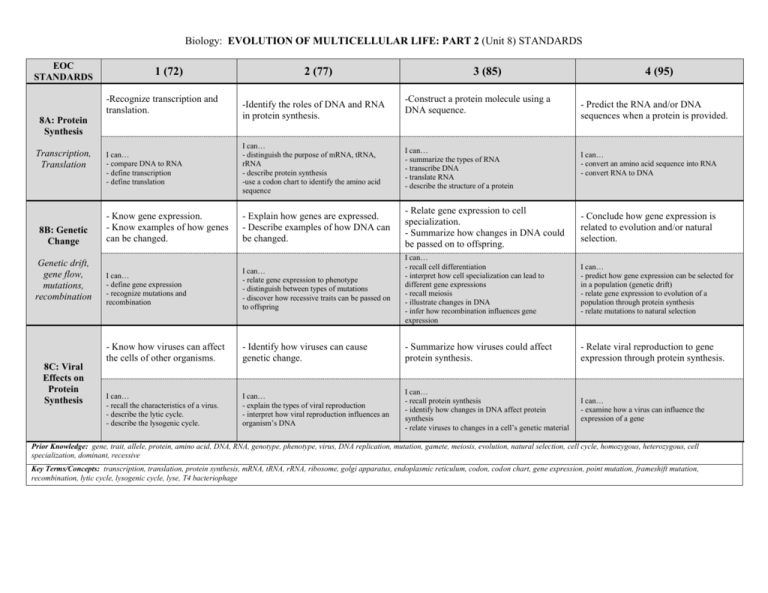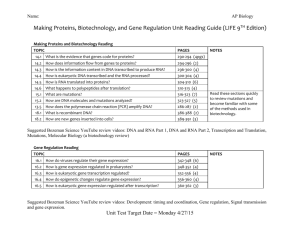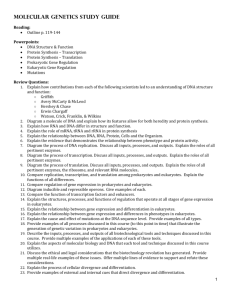unit 8 rubric 11-12
advertisement

Biology: EVOLUTION OF MULTICELLULAR LIFE: PART 2 (Unit 8) STANDARDS EOC STANDARDS 1 (72) -Recognize transcription and translation. 8A: Protein Synthesis Transcription, Translation 8B: Genetic Change Genetic drift, gene flow, mutations, recombination 8C: Viral Effects on Protein Synthesis 2 (77) -Identify the roles of DNA and RNA in protein synthesis. 3 (85) -Construct a protein molecule using a DNA sequence. 4 (95) - Predict the RNA and/or DNA sequences when a protein is provided. I can… - compare DNA to RNA - define transcription - define translation I can… - distinguish the purpose of mRNA, tRNA, rRNA - describe protein synthesis -use a codon chart to identify the amino acid sequence I can… - summarize the types of RNA - transcribe DNA - translate RNA - describe the structure of a protein - Know gene expression. - Know examples of how genes can be changed. - Explain how genes are expressed. - Describe examples of how DNA can be changed. - Relate gene expression to cell specialization. - Summarize how changes in DNA could be passed on to offspring. - Conclude how gene expression is related to evolution and/or natural selection. I can… - define gene expression - recognize mutations and recombination I can… - relate gene expression to phenotype - distinguish between types of mutations - discover how recessive traits can be passed on to offspring I can… - recall cell differentiation - interpret how cell specialization can lead to different gene expressions - recall meiosis - illustrate changes in DNA - infer how recombination influences gene expression I can… - predict how gene expression can be selected for in a population (genetic drift) - relate gene expression to evolution of a population through protein synthesis - relate mutations to natural selection - Know how viruses can affect the cells of other organisms. - Identify how viruses can cause genetic change. - Summarize how viruses could affect protein synthesis. - Relate viral reproduction to gene expression through protein synthesis. I can… - recall the characteristics of a virus. - describe the lytic cycle. - describe the lysogenic cycle. I can… - explain the types of viral reproduction - interpret how viral reproduction influences an organism’s DNA I can… - recall protein synthesis - identify how changes in DNA affect protein synthesis - relate viruses to changes in a cell’s genetic material I can… - examine how a virus can influence the expression of a gene I can… - convert an amino acid sequence into RNA - convert RNA to DNA Prior Knowledge: gene, trait, allele, protein, amino acid, DNA, RNA, genotype, phenotype, virus, DNA replication, mutation, gamete, meiosis, evolution, natural selection, cell cycle, homozygous, heterozygous, cell specialization, dominant, recessive Key Terms/Concepts: transcription, translation, protein synthesis, mRNA, tRNA, rRNA, ribosome, golgi apparatus, endoplasmic reticulum, codon, codon chart, gene expression, point mutation, frameshift mutation, recombination, lytic cycle, lysogenic cycle, lyse, T4 bacteriophage Biology: (UNIT ) STANDARDS – student “I cans” EOC STANDARDS 1 (72) I can … I can … I can … I can … Prior Knowledge: Key Terms/Concepts: 2 (77) 3 (85) 4 (95) Biology: (UNIT ) STANDARDS – Objectives EOC STANDARDS Prior Knowledge: Key Terms/Concepts: 1 (72) 2 (77) 3 (85) 4 (95)









